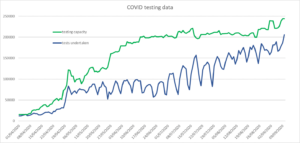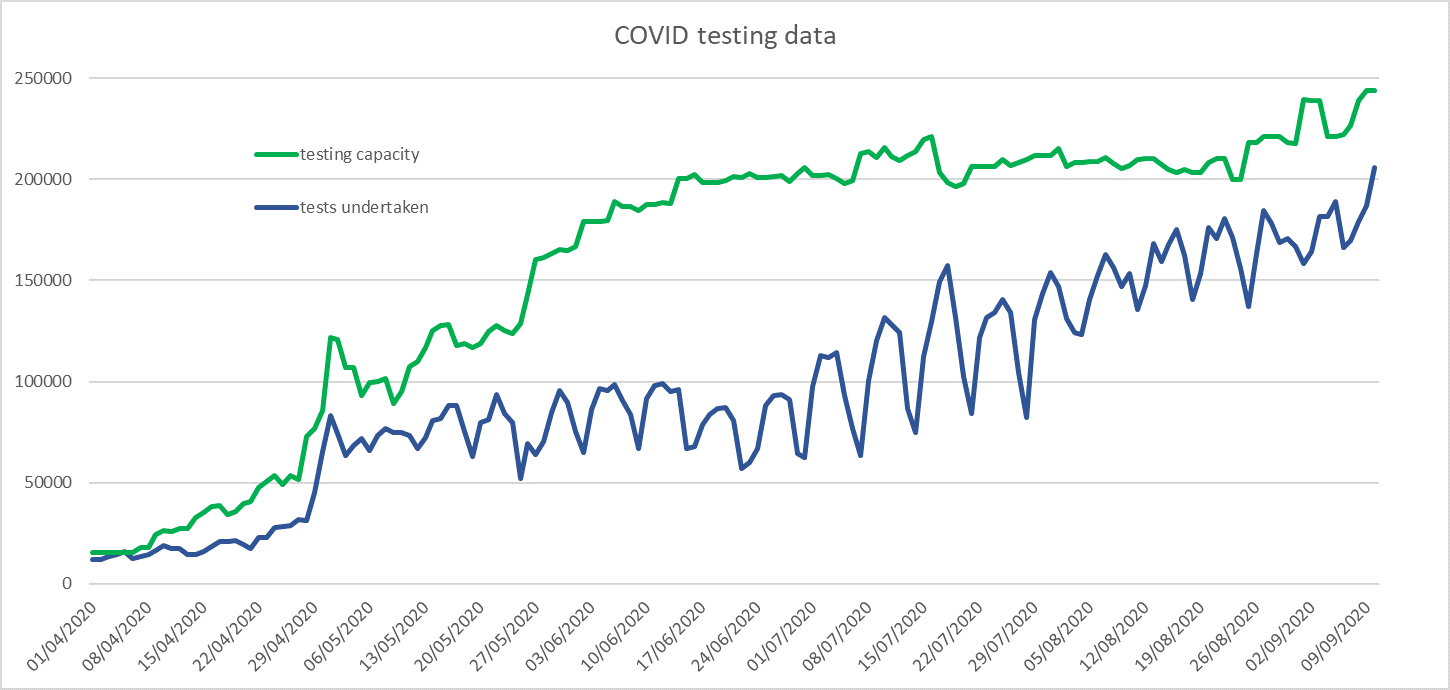24 September 2020
Lies, Damned Lies and Coronavirus
Testing data update
by David Chilvers
This week*, we look at data on the number of tests available and actually undertaken. In the last few days, it has become clear that there are substantial problems with the testing system, with many anecdotal stories of people either being unable to book tests or being asked to travel hundreds of miles to undertake one.
According to the Daily Express website on Sunday 13th September, there were 185,000 unprocessed tests in the system. With around 1.5% of tests currently generating a positive result, the backlog means the number of positive cases has been understated by approximately 3,000. So not only is there a testing issue, there is a consequential issue with the reliability of data on the number of positive cases and how the trend of that is moving.
With pupils returning to schools, any parent would know that colds and sniffles proliferate at this time of year. However, any cold generating an increased temperature or a new cough would be indistinguishable from COVID-19 and schools, not unreasonably, insist that pupils with these characteristics stay at home and book in for a coronavirus test. Until such a test shows a negative result, the pupil and any siblings need to stay at home for 14 days.
You would therefore expect that the capacity to undertake tests would have increased over the summer to deal with this entirely predictable situation. Instead, capacity for swab testing has not increased since early June, as the chart below demonstrates quite clearly:

The blue line shows the number of Pillar 1 and 2 tests undertaken each day, the green line shows total testing capacity for these two tests each day.
You can see that capacity reached 100k in early May and then 200k in early June, both meeting targets that Matt Hancock had set. However, capacity barely increased between early June and the end of August, with just a gentle increase in the first two weeks of September. However, the number of tests undertaken has increased fairly steadily since early July, the unused capacity gradually narrowing. Even without the return to schools and the consequent likely increased demand for testing, capacity would probably have been under strain.
If one looked at this chart in early August, it would have been fairly evident that a problem was developing. Clearly no-one in Government did this (in spite of this data being on the Coronavirus website) and we have yet another example of data being available to highlight a forthcoming problem and no action taken until the problem became acute. At the end of September, we have over a million young adults going or returning to university and it is very likely that this will generate infections and further increase the demand for swab tests.
A quicker and cheaper alternative to throat and nasal swab tests – a saliva test – was piloted in Southampton in June, but not much has been heard of this recently apart from comments that it could be a key component of Operation Moonshine (sorry Moonshot), Boris Johnson’s plan to undertake 10 million tests per day. As we can’t currently manage to undertake 3% of this total, this seems rather far-fetched.
In the early days of the pandemic, the availability of good data was poor and decisions were made in the absence of this. We now have better data (although we have identified a number of issues which limit its utility) but no-one appears to be looking at it to identify potential problems and deal with these before they become major concerns.
This article is one of a series, find the previous article “Local Area Statistics” here.


